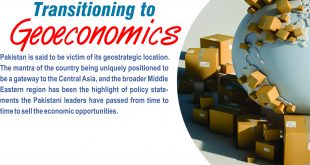In the 1980s, once driving on a busy New York street, I was struck by a popular bumper sticker that read: “One nuclear bomb can ruin your whole day.” On surface, this thought looked childish, if not frivolous, but if taken literally, that bumper sticker did speak the ultimate truth. Indeed, it only takes one, just one nuclear weapon, to destroy our one whole day. But then there will be no other day to follow. This is the crux of the truth that was flagged by the bumper sticker in question to highlight the potential threat of an unparalleled scale of human tragedy that continues to loom large on the horizon.
Surely, no philosophical discourse is needed to understand or agree that nuclear weapons are meant never to be used. They are only a means of ‘deterrence’ and, to an extent seem to have served this purpose during the peak Cold War years. But one must also agree that the risk of a nuclear catastrophe will continue to loom over our heads until the universally acclaimed goal of ‘Global Zero’ is accomplished. The Cold War is long over, yet tens of thousands of nuclear weapons developed as a means of ‘deterrence’ remain in arsenals around the world. Together, the US and Russia alone possess more than 95 percent of the world’s nuclear weapons.
The situation elsewhere is no less alarming. Our own region would have been better off if the famous words uttered by Robert Oppenheimer after he witnessed the power of the Trinity Test, the first nuclear explosion in New Mexico in July 1945, had been given some credence. He was so moved by the spectacle as to spontaneously think of the lines from the Bhagavad-Gita: “If the radiance of a thousand suns were to burst at once into the sky, that would be like the splendour of the mighty one: Now I am become death, the destroyer of worlds.” Let us be clear of one thing. It is not Pakistan which “inducted” the nuclear dimension into the volatile security environment of South Asia.
We never challenged the non-proliferation regime when the NPT was being finalised in 1968. In fact, we supported its objectives. We did not sign the Treaty because India refused to do so and kept pursuing its nuclear-weapon programme. Since the negotiations for the NPT in 1968, every single non-proliferation initiative in our region came from Pakistan. We made several proposals seeking to establish an equitable and non-discriminatory regime in South Asia and to prevent nuclear proliferation in our region. These included a “nuclear weapons-free zone in South Asia, a joint renunciation of acquisition or manufacture of nuclear weapons, and mutual adherence to the NPT.
In June 1991, we proposed a five-nation conference, which was later expanded to also include all permanent members of the UN Security Council, to discuss conventional arms control and confidence-building measures as well as the promotion of nuclear restraint. In 1997, before the UN General Assembly, the Prime Minister of Pakistan proposed mutual and equal restraint by Pakistan and India on the development of nuclear and ballistic missiles. In the absence of any security umbrella, Pakistan on its part was left with no choice but to orient its nuclear programme for defence purposes and to develop an indigenous nuclear and missile capability.
In April 1998, the newly-elected BJP government publicly announced its intentions “to exercise the nuclear option and induct nuclear weapons.” I remember in first week of April, we addressed a letter from our prime minister to the G-8 Heads of State and Government drawing their attention to India’s nuclear intentions and the imminence of its nuclear tests under the new BJP government. India’s five nuclear tests on May 11 and 13, 1998 proved us completely right. For seventeen days after India’s nuclear tests, we waited for the world to do something about our legitimate security concerns. But nothing happened.
In fact, we were advised to exercise restraint and to take the “high moral ground” by not responding in kind. We knew at that time that peace was hanging by a slender thread in South Asia. In the absence of any assurances or security guarantees, we had no choice but to take measures for our own security. Pakistan exploded five nuclear devices on May 28 and followed that up with one more on May 30. No doubt, it was a difficult but inevitable decision. Our tests were an act of self-defence; they established our minimum credible deterrence and also restored the regional strategic balance in South Asia.
The world then did recognise that it was not Pakistan which “inducted” the nuclear dimension into the volatile security environment of South Asia. The formal reaction of the international community, especially the major powers, to South Asian nuclear tests was set out in the UNSC resolution 1172 of 6 June 1998 which, inter alia, condemned the tests and called for a rollback by both countries of their nuclear capabilities, signature of the CTBT, progress on FMCT, and restrictions on missile delivery systems.
The resolution also urged India and Pakistan to resume their dialogue for finding a peaceful solution of the Kashmir issue.
Yes, in those difficult times, we remained under extraordinary pressures and economic sanctions for having demonstrated our nuclear capability. But as a matter of challenge to our foreign policy, we were able to engage the world in a constructive dialogue establishing the rationale of our security interests. The US engaged both India and Pakistan in a “strategic” dialogue on an equal footing. In the last round of their dialogue in February 1999, a clear nuclear parity was established between the two countries in the form of an implicit “strategic linkage” promising them “equality of treatment” in terms of any future concessions including access to technology.
That linkage is no longer there now. Pakistan has been “de-hyphenated” from India. The post-9/11 world has altered the fundamentals of global relations. We now have an altogether new configuration of political power in the world. With overt nuclearization of the sub-continent, South Asia’s problems are no longer an exclusive concern of the region itself. They now have a worrisome global dimension which raises major powers’ stakes in the issues of peace and security in this region. In February 2007, India and Pakistan signed a “nuclear risk reduction” agreement in New Delhi formalizing the provisions of the 21 February 1999 MOU on “nuclear risk reduction measures.”
A nuclear conflict can have no victor. In South Asia, nuclear deterrence may, however, usher in an era of durable peace between Pakistan and India, providing the requisite incentives for resolving all outstanding issues, especially Jammu and Kashmir. The international community should encourage a process of peace and rapprochement, help promote the peaceful resolution of disputes, and support nuclear stabilization and restraint in South Asia. Any measures that contribute to widening of strategic imbalances and fuelling of arms race between the two neighbours are no service to the peoples of the region.
Peace in our region will come not through shady ‘back-channel deals’ but only through meaningful dialogue and constructive engagement for conflict-resolution and peaceful co-existence. Perpetuation of hegemony will not serve the cause of peace. As the largest country in the region, the onus lies with India to inspire confidence among its neighbours. What we need to understand is that war in seventy years did not solve our problems. We perhaps need to give the next seventy years now to peace. This requires steady improvement of relations through changes in the way the two countries deal with each other.
To make this process sustainable, they need a clearer framework of principles to be able to organize their future relations. Depending on progress in building mutual trust and confidence, they will have to explore in due course a mutually agreed permanent mechanism based on mutual renunciation of the use of force and peaceful settlement of disputes. But the success of this process will depend entirely on the freshness of political approach that leadership on both sides would be ready to bring in with sincerity of purpose.
 Jahangir's World Times First Comprehensive Magazine for students/teachers of competitive exams and general readers as well.
Jahangir's World Times First Comprehensive Magazine for students/teachers of competitive exams and general readers as well.



